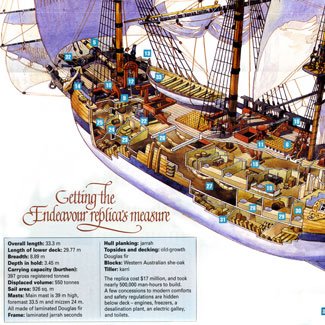Sailing the Endeavour: Day three

AG writer Aaron Cook steps aboard the Endeavour replica to relive the beginnings of Australia’s colonial era, and learn a bit about sailing an 18th century ship. Tune in for his daily blog, thanks to Australian National Maritime Museum.
WHILE EXPLORING THE AUSTRALIAN coast, Cook recorded in his journal his first sighting of people on 22 April 1770 — but high seas stopped him from approaching land. “We had a large hollow Sea from the South-East rowling in upon the land, which beat every where very high upon the Shore,” Cook wrote.
Aboard his ship’s replica, I wonder if the present 2.5 m swell is similar to the experience Cook recorded. As the ship rocks endlessly from side to side, many of my crewmates enter the world of seasickness.
We cycle through watch duties: bow and stern lookouts, rounds to check the safety of the ship, and helming. Two at a time, we get to take the wheel of Endeavour. A compass charts our path and whenever we stray more than a few degrees off course, we swing the wheel a couple of spokes. The wheel action turns the tiller, which turns the rudder that steers the ship. I can’t quite believe I’m steering the Endeavour.

Take a visual tour of the Endeavour View Large Map
NOW THAT WE’RE OFFSHORE, our watery path is lit only by the Milky Way, ablaze against the pitch black night. To the west, a giant dome of lifeless light springs from Sydney. It’s an interesting contrast to see the Milky Way in all its glory, alongside the light pollution that normally prevents city-dwellers from seeing more than a few stars.
The constellation Orion descends, chased by Scorpio through the sky. At this stage, two people require the assistance of a “happy buckets”, PVC buckets with smiley faces drawn in the bottom. On bow lookout I start to feel a bit dodgy. To take my mind off the constant rise and fall I watch the bioluminescence that is sparked off by the wave pushed ahead of Endeavour.
Every time the bow descends, constellations of light appear in the water to match those that hang in the sky above. The cause of this diamond dust is a group of single-celled marine plankton called dinoflagellates, which give off flashes of blue light when disturbed.
BY NEXT MORNING, ABOUT a quarter of the crew have a bucket on hand. Even one of the professional crew is struck down by the dreaded mal de mer — an affliction caused by a disturbance to the body’s balance system in the inner ear. I’m not sure if Cook ever got sea-sick, but there are rumours that Lord Nelson, that other great British sailor, was a chronic sufferer (there’s even a shanty about it).
Luckily, there isn’t much to do today. The officers are happy with the sails that are set and we’re making good ground. After tracking southeast during the night, we have to turn the ship northwest in a technique called “wearing”, similar to a modern day “jibe”.
The rest of the day is plain sailing, but even those that don’t get sick feel at least a little queasy. Tomorrow, we will reach Broken Bay.
Read more from Aaron’s Sailing the Endeavour blog

